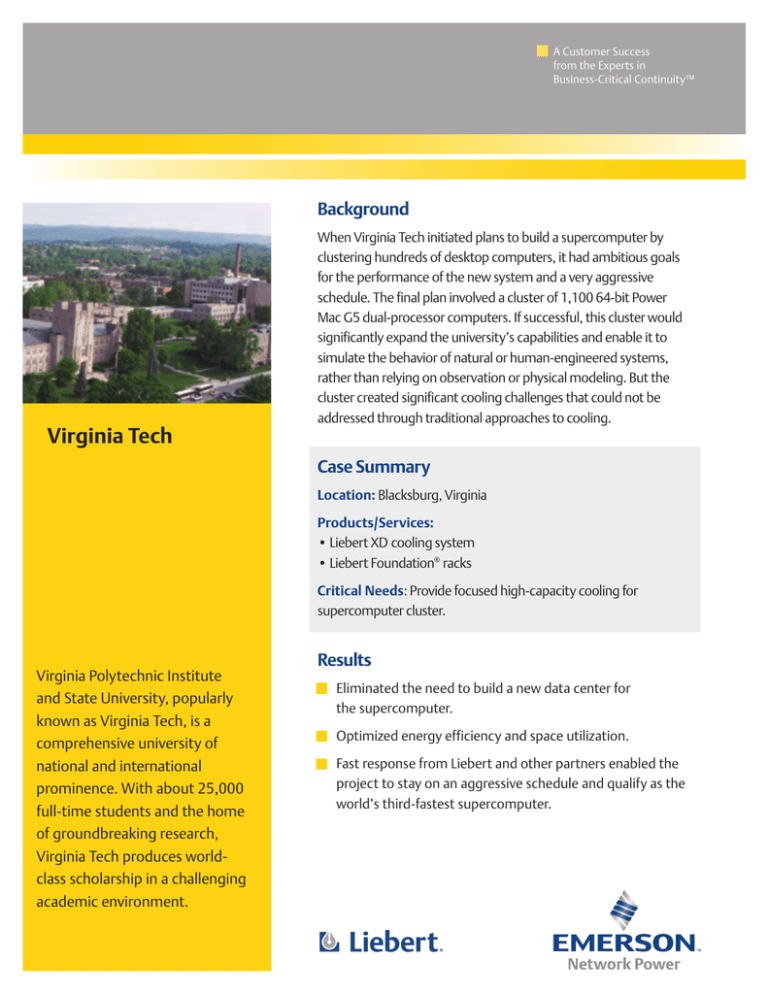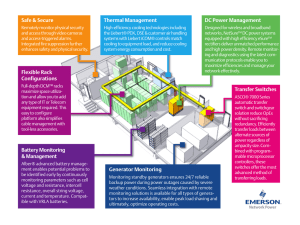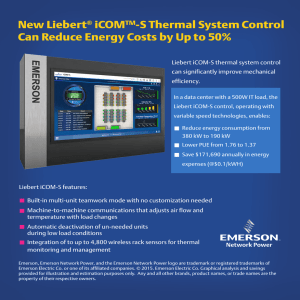
A Customer Success
from the Experts in
Business-Critical Continuity™
Background
When Virginia Tech initiated plans to build a supercomputer by
clustering hundreds of desktop computers, it had ambitious goals
for the performance of the new system and a very aggressive
schedule. The final plan involved a cluster of 1,100 64-bit Power
Mac G5 dual-processor computers. If successful, this cluster would
significantly expand the university’s capabilities and enable it to
simulate the behavior of natural or human-engineered systems,
rather than relying on observation or physical modeling. But the
cluster created significant cooling challenges that could not be
addressed through traditional approaches to cooling.
Virginia Tech
Case Summary
Location: Blacksburg, Virginia
Products/Services:
• Liebert XD cooling system
• Liebert Foundation® racks
Critical Needs: Provide focused high-capacity cooling for
supercomputer cluster.
Results
Virginia Polytechnic Institute
and State University, popularly
known as Virginia Tech, is a
comprehensive university of
national and international
prominence. With about 25,000
full-time students and the home
of groundbreaking research,
Virginia Tech produces worldclass scholarship in a challenging
academic environment.
• Eliminated the need to build a new data center for
the supercomputer.
Optimized energy efficiency and space utilization.
Fast response from Liebert and other partners enabled the
project to stay on an aggressive schedule and qualify as the
world’s third-fastest supercomputer.
A Customer Success
from the Experts in
Business-Critical Continuity™
The Situation
The supercomputer designed by Virginia Tech
computer scientists used 1,100 Macintosh G5
computers clustered using Infiband technology
from MellanoxTM Technologies for primary
communications and Cisco® switches for secondary
communications. The cluster also used a software
program called Déjà vu, developed at Virginia Tech,
to solve the problem of transparent fault tolerance,
enabling large-scale supercomputers to mask
hardware, operating system and software failures.
The project was not only significant to Virginia
Tech. It created a new model for supercomputer
development that could bring supercomputer power
within reach of organizations that had not previously
been able to afford it. But the challenge the scientists
at Virginia Tech were unable to address was keeping
the cluster cool.
The cooling solution for such a high-density room
required a level of innovation along the lines of the
university’s supercomputer itself. Inadequate cooling
would result in processors and switches operating
in dangerously high temperatures, reducing
performance and life span.
Emerson Network Power was prepared to address this
challenge through its Liebert family of cooling
technologies. Liebert power and cooling specialists
played a key role in helping the university understand
the magnitude of the challenge, evaluate alternatives
and configure the room for optimum cooling.
“Liebert really helped open our eyes to the challenge of
heat removal on this project,” says Kevin Shinpaugh,
director of research and cluster computing at Virginia
Tech. “When you are pioneering a new approach as we
“It was clear that traditional approaches to
cooling would not be sufficient by themselves.
Fortunately, Liebert had a solution.”
Kevin Shinpaugh, director of research and cluster computing,
Virginia Tech
were, you are in uncharted waters. Liebert was able to
bring a detailed understanding of the challenge as well
as a very well-developed solution.”
Working with preliminary project specifications,
Liebert specialists analyzed equipment power
consumption and projected heat loads. Then, using
computer air flow modeling, they determined the
optimum arrangement of racks and began to model
different cooling-system configurations.
Each configuration was based on the “hot aisle/
cold aisle” approach to tile placement and rack
arrangement. In this approach, cold aisles have
perforated floor tiles; the hot aisles do not. Racks are
arranged front-to-front so the air coming through the
tiles is pulled in the front of the rack and exhausted out
the back into the hot aisle.
A Customer Success
from the Experts in
Business-Critical Continuity™
Once different approaches had been reviewed, the
specialists analyzed two configurations in depth:
1. Relying exclusively on traditional precision air
conditioning units; specifically, the Liebert
Deluxe System/3.
2. Creating a hybrid solution that combined
traditional computer room air conditioning units
with supplemental cooling provided by the
Liebert XD system.
The Traditional Approach to Cooling
Based on the data available, the Liebert specialists
projected a sensible heat load of 1,972,714 Btu/hr
for the 3,000-square-foot facility.
Assuming this heat load, the room would require
a total of nine Liebert 30-Ton Deluxe System/3
precision air conditioners—seven primary units and
two backups. The seven Deluxe units would generate
a total sensible capacity of 2,069,200 Btu/hr and
106,400 CFM. Based on these CFM requirements,
the facility would need 236 perforated floor tiles,
totaling 944 square feet (based on normal per-tile
airflow of 450 CFM). These tiles would cover nearly
one third of the total floor space.
The engineers then evaluated the effect of raising the
floor from 18 inches to 40 inches to equalize airflow
in the room. This change improved the situation, but
still resulted in less than optimum cooling. A 40-inch
raised floor was impractical because of physical
limitations of the building.
The Hybrid Solution
Precision air conditioning units such as the Liebert
Deluxe System/3 have provided effective cooling
in thousands of data centers around the world;
however, high-density systems, such as the Virginia
Tech supercomputer, are stretching these systems
beyond their practical capacity.
In response, Liebert developed an alternate approach
that uses fewer room-level precision air conditioners,
reducing pressures under the floor, and supplements
these units with rack-based cooling systems.
Airflows were then analyzed using the TileFlow
modeling program, assuming an 18-inch raised floor.
With this configuration, the volume of air being
pumped under the floor created extremely uneven
airflows—from -70 CFM to 1,520 CFM.
In addition, under-floor pressures and velocities
demonstrated significant tumult beneath the floor,
reducing cooling system efficiency and creating the
potential for hot spots that could damage the
computers and reduce availability.
Airflow analysis across one row of racks using floor
mount precision air conditioners with 18-inch
raised floor.
A Customer Success
from the Experts in
Business-Critical Continuity™
Liebert specialists analyzed airflow from two 20-ton
Liebert Deluxe units and confirmed that the two units
achieved a more uniform air flow; variance within the
room was reduced from more than 400 CFM to less
than 100 CFM. With uniform airflow established,
Liebert specialists calculated the optimum
configuration of supplemental cooling systems
using the Liebert XD system.
“Liebert was one of the few companies that had
developed a viable cooling solution for high-density
computer configurations,” says Patricia Arvin, associate
vice president, information systems and computing,
Virginia Tech.
“It was clear that traditional approaches to cooling
would not be sufficient by themselves,” adds
Shinpaugh. “Fortunately, Liebert had a solution.”
The Liebert XD is a flexible, scalable and waterless
solution to supplemental cooling that delivers
sensible cooling of heat densities higher than 500
Watts per square foot.
The Liebert XD family uses an environmentally friendly
coolant to achieve high efficiencies and waterless
cooling. The coolant is pumped as a liquid, converts to
a gas within the heat exchangers, and then is returned
to the pumping station, where it is re-condensed to
liquid. The system achieves high efficiencies by placing
the cooling system close to the heat source and
utilizing the heat absorption capacity of a fluid
changing state.
The Liebert XD family includes vertical rack-mounted
fan coils (Liebert XDV modules) and ceiling-mounted
fan coils (Liebert XDO modules). Based on available
“Liebert has been an extraordinary partner in this
endeavor. It’s rare to find a company that can act
so quickly and be so agile in responding to a
customer’s needs. It’s like having a Ferrari custom
designed and built with the efficiency of a Toyota.
We are very impressed.”
Patricia Arvin, associate vice president, information systems
and computing, Virginia Tech
ceiling height, Liebert recommended the Liebert
XDV for both hybrid configurations presented to
Virginia Tech.
One Liebert XDV cooling module was recommended
for every other rack. This configuration provides ample
cooling capacity to meet initial requirements, with the
ability to expand capacity should heat densities
increase as a result of changes to, or expansion of,
the supercomputer.
The Liebert XD system can utilize its own chillers or
connect to the building chilled water system. Both
options were analyzed for Virginia Tech. Liebert and
Virginia Tech selected reciprocating air-cooled chillers,
which supply chilled water to the Liebert XDP Heat
Exchanger/Pumping module.
A Customer Success
from the Experts in
Business-Critical Continuity™
The Solution
Based on the detailed analysis conducted by the
Liebert engineers, it was clear that the combination
of two Liebert 20-ton Deluxe System/3 room air
conditioners and 48 Liebert XDV supplemental cooling
modules delivered the optimum cooling solution for
the supercomputer facility.
To further ensure proper performance of the cooling
system, Liebert custom-built the racks for the Power
Macs. In addition, Liebert provided the three-phase
UPS system that provides backup power and
conditioning for the supercomputer cluster.
And, the results have been impressive. In its first year of
operation, the Virginia Tech supercomputer achieved
speeds of 10.28 teraflops, making it the third-fastest
supercomputer in the world.
“Liebert has been an extraordinary partner in this
endeavor,” says Arvin. “They worked with us to find
a solution to every problem we’ve encountered,
and they have done it in record time. It’s rare to find
a company as large as Liebert that can act so quickly
and be so agile in responding to a customer’s needs.
It’s like having a Ferrari custom designed and built with
the efficiency of a Toyota. We are very impressed.”
But then, Virginia Tech has done no less itself by
building one of the most advanced super computers
in the world, using basic desktop components.
The Results
Within less than three months of receiving the
preliminary specifications for the room, Liebert had
analyzed multiple cooling system configurations,
developed the optimum room layout and cooling
solution, custom designed racks to equipment
requirements and provided the power and cooling
equipment for the new supercomputer.
According to the New York Times, the computer
“was put together in a virtual flash.”
Emerson Network Power.
The global leader in enabling Business-Critical Continuity™.
EmersonNetworkPower.com
AC Power
Embedded Computing
Outside Plant
Racks & Integrated Cabinets
Connectivity
Embedded Power
Power Switching & Control
Services
DC Power
Monitoring
Precision Cooling
Surge Protection
While every precaution has been taken to ensure accuracy and completeness in this literature, Liebert Corporation assumes no responsibility, and disclaims all liability for damages
resulting from use of this information or for any errors or omissions. Specifications subject to change without notice. © 2006 Liebert Corporation. All rights reserved throughout
the world. Trademarks or registered trademarks are property of their respective owners. ® Liebert and the Liebert logo are registered trademarks of the Liebert Corporation.
Business-Critical Continuity, Emerson Network Power and the Emerson Network Power logo are trademarks and service marks of Emerson Electric Co. © 2006 Emerson Electric Co.
1206





